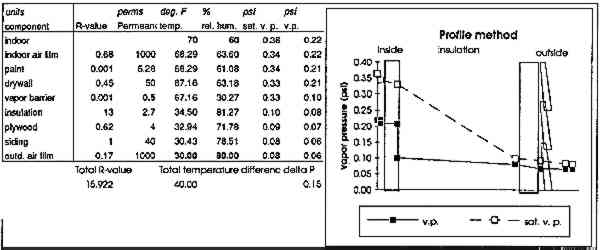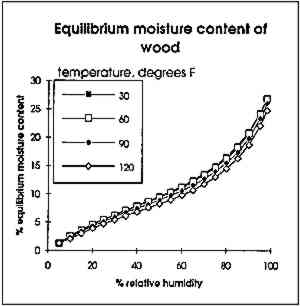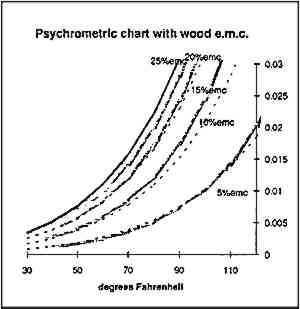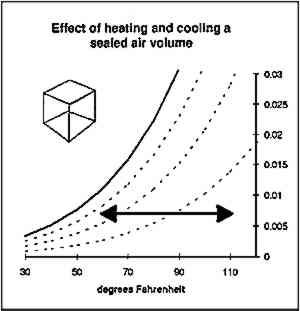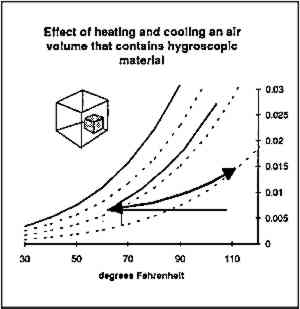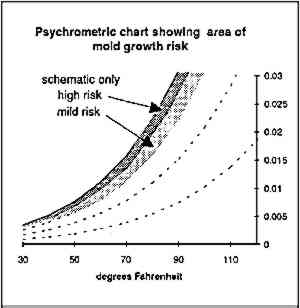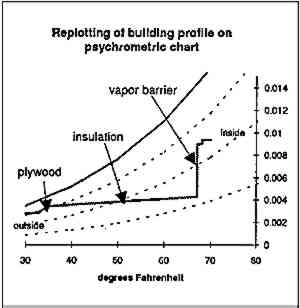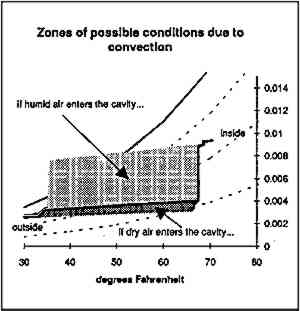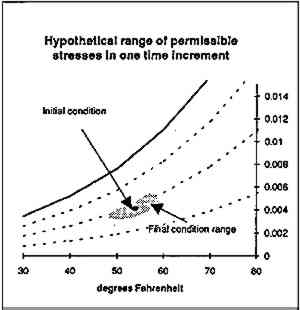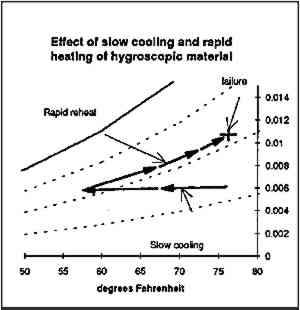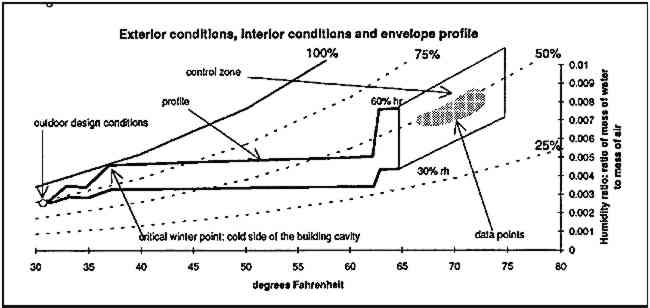EFFECTS OF CLIMATE CONTROL ON THE MUSEUM BUILDING ENVELOPEWILLIAM ROSE
ABSTRACT—The museum building is sometimes called “the major artifact in the collection.” The building envelope serves as the boundary between the indoor conditions and the outdoor conditions. Any difference between indoor and outdoor temperature or humidity produces stress on the envelope, in the same way that air changes within the museum environment can stress a museum artifact. Although building envelopes are designed to resist stress, excessively tight indoor control can be harmful to the envelope. In a well-controlled environment, a balance is achieved between the stresses on the envelope and those on the artifacts.This paper presents the standard methods for analyzing the hygrothermal performance of a building assembly and describes the limitations of those methods. Next the paper presents a review of psychrometrics—the science of air-water interactions. The psychrometric chart is used as the base for introducing the effects that are missing from standard building performance analysis: moisture content of materials, air convection, and time-dependent effects. Practical matters presented include: setting upper and lower humidity limits in the exhibition space; temperature and moisture distributions in a space and in a climate control zone; the winter and summer performance of mechanical equipment; instrumentation; and building monitoring. Finally, guidelines for climate control that are aimed at maintaining the museum building envelope are presented. 1 INTRODUCTIONThe focus of this paper is the effect of indoor climate control on the museum building envelope. The climate control system includes all of the equipment providing heating, humidification, cooling, and dehumidification. Managing humidity in a building requires before all else that there be no roof leaks and no entry of liquid water through the building foundation. Some terms should be defined at the outset:
Many museums are in older buildings. Indeed, one of the first uses often considered in adaptive use of historic property is as a museum. Typically, the original building envelope was designed to work compatibly with the original climate control system. It is correct to assume that a changed climate control system will have an effect on the envelope unforeseen by the original designer. Only proper study can reveal the likelihood of damage to the envelope. To the chagrin of many conservators and museum administrators, many new systems have been found to perform undependably, produce erratic and nonuniform conditions, and have unwelcome effects on the building envelope. To determine why some systems succeed and others fail requires a critical review of the standard methods of envelope analysis. This paper presents a new method of portraying some of the temperature and humidity information that is readily found in building science literature. It illustrates the use of the psychrometric chart as a base of information on temperature and humidity. 2 PROFILING ANALYSISMost design of building envelopes, including museum building envelopes, is based on the American Society of Heating Refrigeration and Air Conditioning Engineers profiling method of envelope analysis (ASHRAE 1989)(fig. 1). Using this technique, a designer applies the following steps:
If the profile lines cross, methods are available to estimate the quantity of condensation. This method assumes heat transfer is by conduction and vapor transport is by diffusion. This technique produces information about the likelihood of moisture condensation, and, if pursued at length, the quantities of condensation can be calculated. This technique is based on sound physical theory, of course, but it contains several simplifying assumptions that limit its usefulness. This technique assumes that:
In the last several years, these assumptions have been called into question. The profiling technique often gives results that do not square with actual findings when it is applied to wall and roof construction that contains air cavities. Many researchers have shown that moisture movement in cavity walls and roof systems is by air movement or convection rather than by diffusion (Hutcheon 1959). The convection and radiation components of heat transfer are significant in building assemblies that contain cavities. Permeance values are not known with accuracy (Toas 1989), and they are variable, particularly with moisture content changes. Burch (1992) showed that permeability increases exponentially with relative humidity. There is so much moisture stored in a wood or brick wall that it may require several weeks or months for the wall to reach equilibrium with the surrounding conditions. In short, designers should not rely solely on standard profiling techniques when trying to predict the effect of changing indoor conditions on a building assembly. An advanced investigation of the hygrothermal performance of buildings requires a review of the physics involved. 3 PSYCHROMETRICSThe science of air-water interactions is called psychrometrics. Most of psychrometrics is embodied in the psychrometric chart (fig. 2). The horizontal axis shows temperature or the kinetic energy of the air molecules. The vertical axis indicates the absolute humidity, that is, the mass of water molecules in the air. Absolute humidity can be indicated by several parameters, including vapor pressure and dew
The bold line on this chart is the line of saturation, and it indicates that warmer air can hold more moisture. Air that holds all the moisture it can hold is said to be at saturation, or 100% relative humidity. The percent degree of saturation of air is called relative humidity. On the psychrometric chart, the four processes of heating, cooling, wetting, and drying are indicated by four arrows. As can be seen, the relative humidity can be changed by changing either the humidity mass or the temperature of the air. Air that is cooled to saturation is said to have reached its dew point temperature. The psychrometric charts used by mechanical engineers contain many other lines, indicating wet-bulb temperature, enthalpy, and volume. Some of these lines can be useful: the volume of air, for example, can be used as a first-order estimate of the air leakage from a display case resulting from temperature changes within the case. The extra lines on the psychrometric chart can be ignored for the moment, particularly since the purpose of this article is to add lines to the psychrometric chart indicating relations between air and the materials that it surrounds. 4 SORPTIONMost organic materials and many mineral materials are hygroscopic, that is, they adsorb and desorb moisture, and they have a measurable moisture content. They are also porous, and so the air entrained within the materials can be monitored for temperature and humidity. The moisture content can be measured by standard gravimetric techniques (successive oven drying and weighting), and the results can be compared against temperature and
Sorption data for other materials are readily available (IEA 1991). Overlays of lines of constant moisture content for other materials can be prepared easily from the data or from charts of sorption isotherms. Such overlays can be very helpful: they can indicate the moisture content of materials in a building envelope assembly if the temperature and humidity are known at any point in that assembly. It is readily apparent that the lines of constant moisture content correspond closely to the lines of relative humidity. The aim of museum environments is to maintain close to constant moisture content in the artifacts; thus, maintaining somewhat constant relative humidity is desirable. Artifacts and their environment are in a constant state of moisture exchange, sometimes driven by temperature, sometimes driven by differing vapor pressure. The effect of this exchange is illustrated in figures 5, 6, and 7. Figure 5 shows heating and cooling of a sealed air volume. No moisture is added or subtracted by changing temperature. Figure 6 shows the psychrometric effect of heating and cooling a sealed hygroscopic material such as wood. The line shown represents constant moisture content, because in a sealed material no moisture moves across the outside seal. Both of these conditions are ideal. The real-world condition is that shown in figure 7, in which a hygroscopic material is surrounded by an air volume. This example corresponds to an artifact in a case or furnishings in a room. As the case or room is heated and cooled, the psychrometric conditions would follow a curve somewhere between the curves indicated in
Given that relative humidity can be changed by heating, cooling, wetting, or drying, it is evident that moisture content of hygroscopic materials can be changed by the same four processes. 5 DAMAGEData are available showing the conditions of temperature and humidity under which damage to materials can occur (Nicholas 1973). One such kind of damage is from mold, which may grow where the relative humidity at the surface is around 80% or above. As with the sorption isotherm chart (fig. 3), the data can be extracted from the chart and used to estimate zones of mold growth (fig. 8). This example does not use varying moisture content at the surface as a parameter of growth, but such information could be used to plot lines of constant growth rates with their associated risk.
It has been suggested (Michalski 1991) that environmental conditions for artifacts should be described using damage risk associated with that set of conditions. Psychrometric plotting of potential damage conditions can achieve this goal. 6 PSYCHROMETRIC PROFILINGThe final step in this analysis involves replotting the results of profiling (fig. 1) onto a psychrometric chart. The ASHRAE fundamentals handbook (ASHRAE 1989) gives the relations and coefficients used to achieve the replotting (fig. 9). As this plot indicates, there is a continuous segmented line that contains the same information as the two lines (vapor pressure and saturation vapor pressure) arising from the profile analysis.
The advantage of replotting the profile is this: overlays of material moisture contents and damage potential can be superimposed on the profile, giving an instant indication of the moisture content at any point in the assembly and noting any risk associated with conditions within the assembly. In the hypothetical case shown, the inside of the sheathing would be at a high moisture content, but below saturation and at a temperature too low to permit extensive mold growth. This technique overcomes the first problem posed by classical profiling techniques: that the information put out is sketchy. Now the information can include moisture content and damage risk. But the other simplifying assumptions (convection and transient effects) must be addressed. 7 CONVECTIONFor the past 40 years, studies have shown the relative importance of air leakage (convection) over diffusion as a means of transporting moisture through building assemblies. Air convection is a function of air pressure difference and leakage area. The air pressure driving forces are established by wind, thermal buoyancy (warm air rising), and mechanical systems. Mechanical systems are the dominant force in most large buildings. The impact of air convection or air leakage is that cavities in building assemblies tend to be filled with air of the same psychrometric conditions as the air on the source side. Cavity conditions could be described as potentially occupying all of the psychrometric conditions shown in figure 11, depending on several variables, including: (1) direction of air flow; (2) pressure drive; (3) leakage area; and (4) path through the cavity. The best air pressure balance is neutral or minimal air pressure difference, where there is little air exchange across the assembly. Most Given the importance of air convection, the exact values of vapor permeances of materials can be seen to be of minimal importance. Of greater importance is the integrity of the air barrier, which can protect cavities from damaging effects of air leakage into and out of the cavity. And of even greater importance is achieving effective control of the air pressure differences across the building envelope. 8 HEAT AND MOISTURE STORAGEAll of the above analysis is steady state, that is, it ignores changing conditions. The impact of changing conditions depends on the heat and moisture storage capacity of the materials in the assembly. Mathematical models exist, but as they grow in complexity, they often become computationally unstable and thus less usable. It may be sufficient to know that buildings store only a small amount of heat but great amounts of water. The amount of water stored in building materials may amount to 3% to 5% of the total building mass. Buildings react to changes in thermal environments in a matter of minutes or a few hours. Buildings react to changes in the moisture environment in a matter of days or a few weeks. Much concern has been expressed for thermal and moisture shocks to artifacts and building materials. This paper does not attempt to ascribe a value to acceptable or unacceptable shocks, but the psychrometric technique illustrated does allow a permissible shock “envelope” to be portrayed visually (see fig. 11). From an initial point, the zone of permissible conditions after one time increment could be shown on a psychrometric chart. That zone would probably have a shape somewhat like the one shown, which follows roughly a line of constant moisture content.
Mechanical stresses in materials are usually a consequence of dimensional changes resulting from differential thermal and moisture changes in materials. This paper will not attempt to analyze these effects, but they can be illustrated with an example. In one museum several artifacts from a collection were damaged overnight due to climate control problems. Slip had fallen from several ceramic objects, and paint had peeled from polychromed wood. Upon investigation, it turned out that the indoor temperature had grown gradually colder by about 5�F over several days due to a malfunction in the mechanical controls. A disgruntled building user then vandalized the thermostat and elevated the indoor temperature quickly. The effect on the artifacts could be explained using the “popcorn” analogy (fig. 12). The gradual cooling allowed an increase in the moisture content of the material, with no effect on the outside coating. However, the rapid reheating permitted an increase in the vapor pressure inside the artifact, and the pressure could not be relieved quickly because of the relatively impermeable coating. The coating then gave way. In this same way, popcorn can be chilled in the refrigerator to achieve a high moisture content and then heated to achieve the maximum popping of the kernels.
9 SETTING HUMIDITY LIMITSAn informal standard exists for the upper limit for humidity within a building during the heating season: humidity should be low enough to prevent running condensation on windows. This standard is difficult to use as a design value for new construction or remodeling, but it is quite useful for operation and control. There is a growing consensus among building scientists that during the heating season an indoor relative humidity of 50% is too high. Humidity control Air conditioning consists of passing air across a chilled coil. The coil lowers the temperature of the air, and it removes moisture. Lowering the temperature is called sensible cooling, and humidity removal is called latent cooling. Providing the appropriate ratio of sensible to latent cooling is a matter of sophisticated system design, control, and operation. Correctly balanced sensible and latent cooling cannot easily be achieved with temperature control only. Most collections would benefit from humidity control, that is, from providing a humidity sensing device that can override the operation of the air handling unit. Humidity control could prevent collections from being subjected to extreme dryness during the coldest days and extremely high relative humidity during the hottest days. (Most systems fail mechanically or fail to deliver the proper air at those times.) One simple humidity control strategy consists of having the humidity sensor shut off the temperature control once a critical level of wetness or dryness is reached. Suppose that during the winter a critical low indoor relative humidity level is reached. The sensor could shut off the heating unit, the temperature would fall, and, consequently, the relative humidity would rise. During the cooling season, if indoor relative humidity rose above a critical value, the air conditioning could shut off, the indoor temperature would rise, and the relative humidity would decrease. In both cases, staff and visitor comfort would be sacrificed for stability of the collection. Setting appropriate indoor humidity levels via control is important. But more important is 10 BUILDING MONITORINGStrip charts can be used for determining maximum and minimum values, identifying sharp spikes or changes in temperature or humidity, and establishing proof of appropriate control for visiting collections. However, strip chart hygrometers are recalibrated infrequently, so the output is suspect. Temperature and humidity data are collected but very little are analyzed. Electronic monitoring is becoming more common. Electronic data logging has several advantages over analog, recording, including facilitated microcomputer analysis of data, alarm and prompt commands, digital readout, wider range of probe instruments, conversion of output units, and the possibility of having monitoring equipment interface with the air handling system control. Electronic monitoring requires professional judgment in the selection of instruments and equipment and in the selection of locations for probe placement. Possible probe locations should be reviewed for criticality and likelihood of damage. If the building and artifacts were described as a chain, the monitoring system should record the condition of the most valuable links and of the weakest links. Recorded temperature and humidity data can be plotted on a psychrometric chart. It would be most common to see a cluster of data points like those shown in figure 13. These data points could represent data from one probe location over time, probes from several locations at one time, or both. The slight upward slope of the cluster recalls the typical condition of moisture interaction between a
Building monitoring usually involves some monitoring of the outdoor conditions. Figure 13 illustrates an overlay of (1) outdoor design conditions; (2) indoor data points; (3) a zone that limits the permissible and possible indoor conditions; and (4) a profile line connecting the indoors and outdoors. By allowing a more widely defined control zone, the stress on the envelope can be reduced. The benefits during winter of lowered indoor relative humidity are evident. 11 CONCLUSIONSThis article demonstrates a technique for analyzing the heat and moisture performance of a building envelope assembly. The technique is based on classical methods but extends the amount of information both put in and extracted. It combines standard psychrometrics with information from known references regarding the moisture contents of materials. The technique contains some allowance for convective and transient effects, and it provides an indication of material moisture contents and potential for damage. The technique also allows acceptable hygrothermal ranges and permissible hygrothermal shocks for artifacts to be described visually. Humidity settings for the indoor air of museums are discussed. The only current guideline for winter performance is that running window condensation indicates excessive humidity. During the summer, achieving proper balance between lowering the air temperature and removing humidity requires a certain sophistication of system design and operation. Humidity control that overrides temperature control during periods of extreme outdoor conditions is recommended. Building instrumentation is discussed and the advantages of digital recording of data are highlighted. The clustering of data points on a psychrometric chart is described, using the psychrometric analysis above as a guide. The relationship between the clustering of indoor conditions and stresses on the building enveloped are portrayed on the psychrometric chart, but they are not analyzed in detail. All of the above assumes that the only moisture contributions to the museum air are those accounted for by human use and mechanical provision. However, many buildings have leaky roofs and foundations that seep groundwater from the surrounding soil. Humidity control is not possible in buildings with leaky roofs or foundations. Correcting these defects must have first priority. REFERENCESASHRAE, 1989. 1989 ASHRAE handbook of fundamentals. Atlanta: American Society of Heating Refrigeration and Air Conditioning Engineers. BurchD. M., W. C.Thomas, and A. H.Fanney. 1992. Water vapor permeability measurements of common building materials. In Minutes and proceedings, CIB-W40 heat and moisture transfer in buildings. Rotterdam: Congr�s International de B�timent. FPL. 1991. Wood handbook. Madison, Wis: Forest Products Laboratory, U. S. Department of Agriculture. Hutcheon, N. B.1959. Vapour problems in thermal insulation. NRC 4920, Division of Building Research, National Research Council of Canada. Ottawa, NRC. IEA. 1991. Catalogue of material properties. In International Energy Agency Annex XIV, Condensation and Energy, vol. 3. Leuven, Belgium: Catholic University of Leuven.
Michalski, S.1991. Towards specific humidity guidelines for artifacts and minimal-intervention control. Proceedings of the AIC/APT Museums in Historic Buildings Symposium. Fredericksburg, Va.: Association for Preservation Technology. Nicholas, D. D.1973. Wood deterioration and its prevention by preservative treatments. In Degradation and protection of wood, vol. 1. Syracuse Wood Science series 5, ed. D. D.Nicholas. Syracuse, N.Y.: Syracuse University Press. Toas, M.1989. Results of the 1985 round-robin test series using ASTM E96-80. In Water vapor transmission through building materials and systems: Mechanisms and measurement, ASTM STP 1093, ed. H. R.Trechsel and M.Bomberg. Philadelphia: American Society for Testing and Materials. AUTHOR INFORMATIONWILLIAM B. ROSE is a research architect with the Building Research Council, University of Illinois in Urbana-Champaign. His principal field of research is in heat, air, and moisture movement in buildings. He has consulted with several museums and historic properties regarding climate control and moisture conditions. He is an instructor for the Getty Conservation Institute course on preventive conservation. He authored the chapter on existing residential construction for the ASTM manual Moisture Control in Buildings. Address: William B. Rose, Building Research Council, 1 E. St. Mary's Road, Champaign, Ill. 61820.
 Section Index Section Index |
